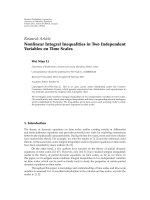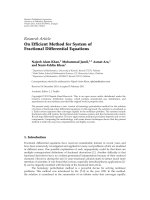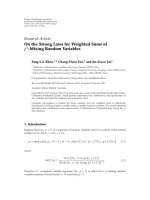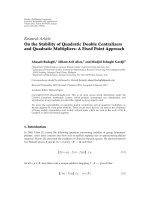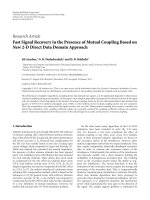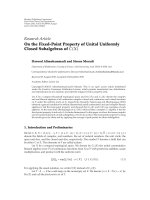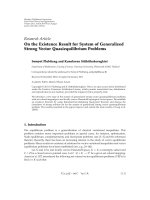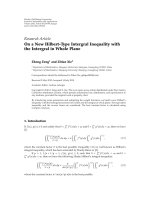Báo cáo hóa học: " Research Article On Hadamard-Type Inequalities Involving Several Kinds of Convexity" pot
Bạn đang xem bản rút gọn của tài liệu. Xem và tải ngay bản đầy đủ của tài liệu tại đây (493.72 KB, 12 trang )
Hindawi Publishing Corporation
Journal of Inequalities and Applications
Volume 2010, Article ID 286845, 12 pages
doi:10.1155/2010/286845
Research Article
On Hadamard-Type Inequalities Involving Several
Kinds of Convexity
Erhan Set,
1
M. Emin
¨
Ozdemir,
1
and Sever S. Dragomir
2, 3
1
Department of Mathematics, K.K. Education Faculty, Atat
¨
urk University, Campus,
25240 Erzurum, Turkey
2
Research Group in Mathematical Inequalities & Applications, School of Engineering & Science,
Victoria University, P.O. Box 14428, Melbourne City, VIC 8001, Australia
3
School of Computational and Applied Mathematics, University of the Witwatersrand, Private Bag 3,
Wits 2050, Johannesburg, South Africa
Correspondence should be addressed to Erhan Set,
Received 14 May 2010; Accepted 23 August 2010
Academic Editor: Sin E. I. Takahasi
Copyright q 2010 Erhan Set et al. This is an open access article distributed under the Creative
Commons Attribution License, which permits unrestricted use, distribution, and reproduction in
any medium, provided the original work is properly cited.
We do not only give the extensions of the results given by Gill et al. 1997 for log-convex functions
but also obtain some new Hadamard-type inequalities for log-convex m-convex, and α, m-convex
functions.
1. Introduction
The following inequality is well known in the literature as Hadamard’s inequality:
f
a b
2
≤
1
b − a
b
a
f
x
dx ≤
f
a
f
b
2
,
1.1
where f : I → R is a convex function on the interval I of real numbers and a, b ∈ I with
a<b.This inequality is one of the most useful inequalities in mathematical analysis. For new
proofs, note worthy extension, generalizations, and numerous applications on this inequality;
see 1–6 where further references are given.
2 Journal of Inequalities and Applications
Let I be on interval in R. Then f : I → R is said to be convex if, for all x, y ∈ I and
λ ∈ 0, 1,
f
λx
1 − λ
y
≤ λf
x
1 − λ
f
y
1.2
see 5, Page 1. Geometrically, this means that if K, L,andM are three distinct points on the
graph of f with L between K and M, then L is on or below chord KM.
Recall that a function f : I → 0, ∞ is said to be log-convex function if, for all x, y ∈ I
and t ∈ 0, 1, one has the inequality
see 5, Page 3
f
tx
1 − t
y
≤
f
x
t
f
y
1−t
.
1.3
It is said to be log-concave if the inequality in 1.3 is reversed.
In 7, Toader defined m-convexity as follows.
Definition 1.1. The function f : 0,b → R, b>0issaidtobem-convex, where m ∈ 0, 1,if
one has
f
tx m
1 − t
y
≤ tf
x
m
1 − t
f
y
1.4
for all x, y ∈ 0,b and t ∈ 0, 1. We say that f is m-concave if −f is m-convex.
Denote by K
m
b the class of all m-convex functions on 0,b such that f0 ≤ 0 if
m<1. Obviously, if we choose m 1, Definition 1.1 recaptures the concept of standard
convex functions on 0,b.
In 8, Mihes¸an defined α, m-convexity as in the f ollowing:
Definition 1.2. The function f : 0,b → R, b>0, is said to be α, m-convex, where α, m ∈
0, 1
2
, if one has
f
tx m
1 − t
y
≤ t
α
f
x
m
1 − t
α
f
y
1.5
for all x, y ∈ 0,b and t ∈ 0, 1.
Denote by K
α
m
b the class of all α, m-convex functions on 0,b for which f0 ≤ 0.
It can be easily seen that for α, m1,m, α, m-convexity reduces to m-convexity and for
α, m1, 1, α, m-convexity reduces to the concept of usual convexity defined on 0,b,
b>0.
For recent results and generalizations concerning m-convex and α, m-convex
functions, see 9–12.
In the literature, the logarithmic mean of the positive real numbers p, q is defined as
the following:
L
p, q
p − q
ln p − ln q
p
/
q
1.6
for p q,weputLp, pp.
Journal of Inequalities and Applications 3
In 13, Gill et al. established the following results.
Theorem 1.3. Let f be a positive, log-convex function on a, b.Then
1
b − a
b
a
f
t
dt ≤ L
f
a
,f
b
, 1.7
where L·, · is a logarithmic mean of the positive real numbers as in 1.6.
For f a positive log-concave function, the inequality is reversed.
Corollary 1.4. Let f be positive log-convex functions on a, b.Then
1
b − a
b
a
f
t
dt ≤ min
x∈
a,b
x − a
L
f
a
,f
x
b − x
L
f
x
,f
b
b − a
.
1.8
If f is a positive log-concave function, then
1
b − a
b
a
f
x
dx ≥ max
x∈
a,b
x − a
L
f
a
,f
x
b − x
L
f
x
,f
b
b − a
.
1.9
For some recent results related to the Hadamard’s inequalities involving two log-
convex functions, see 14 and the references cited therein. The main purpose of this paper
is to establish the general version of inequalities 1.7 and new Hadamard-type inequalities
involving two log-convex functions, two m-convex functions, or two α, m-convex functions
using elementary analysis.
2. Main Results
We start with the following theorem.
Theorem 2.1. Let f
i
: I ⊂ R → 0, ∞i 1, 2, ,n be log-convex functions on I and a, b ∈ I
with a<b. Then the following inequality holds:
1
b − a
b
a
n
i1
f
i
x
dx ≤ L
n
i1
f
i
a
,
n
i1
f
i
b
, 2.1
where L is a logarithmic mean of positive real numbers.
For f a positive log-concave function, the inequality is reversed.
4 Journal of Inequalities and Applications
Proof. Since f
i
i 1, 2, ,n are log-convex functions on I, we have
f
i
ta
1 − t
b
≤
f
i
a
t
f
i
b
1−t
2.2
for all a, b ∈ I and t ∈ 0, 1. Writing 2.2 for i 1, 2, ,n and multiplying the resulting
inequalities, it is easy to observe that
n
i1
f
i
ta
1 − t
b
≤
n
i1
f
i
a
t
n
i1
f
i
b
1−t
n
i1
f
i
b
n
i1
f
i
a
f
i
b
t
2.3
for all a, b ∈ I and t ∈ 0, 1.
Integrating inequality 2.3 on 0, 1 over t,weget
1
0
n
i1
f
i
ta
1 − t
b
dt ≤
n
i1
f
i
b
1
0
n
i1
f
i
a
f
i
b
t
dt.
2.4
As
1
0
n
i1
f
i
ta
1 − t
b
dt
1
b − a
b
a
n
i1
f
i
x
dx,
2.5
1
0
n
i1
f
i
a
f
i
b
t
dt
1
n
i1
f
i
b
L
n
i1
f
i
a
,
n
i1
f
i
b
,
2.6
the theorem is proved.
Remark 2.2. By taking i 1andf
1
f in Theorem 2.1, we obtain 1.7.
Corollary 2.3. Let f
i
: I ⊂ R → 0, ∞i 1, 2, ,n be log-convex functions on I and a, b ∈ I
with a<b.Then
1
b − a
b
a
n
i1
f
i
x
dx
≤ min
x∈
a,b
x − a
L
n
i1
f
i
a
,
n
i1
f
i
x
b − x
L
n
i1
f
i
x
,
n
i1
f
i
b
b − a
.
2.7
Journal of Inequalities and Applications 5
If f
i
i 1, 2, ,n are positive log-concave functions, then
1
b − a
b
a
n
i1
f
i
x
dx
≥ max
x∈
a,b
x − a
L
n
i1
f
i
a
,
n
i1
f
i
x
b − x
L
n
i1
f
i
x
,
n
i1
f
i
b
b − a
.
2.8
Proof. Let f
i
i 1, 2, ,n be positive log-convex functions. Then by Theorem 2.1 we have
that
b
a
n
i1
f
i
t
dt
x
a
n
i1
f
i
t
dt
b
x
n
i1
f
i
t
dt
≤
x − a
L
n
i1
f
i
a
,
n
i1
f
i
x
b − x
L
n
i1
f
i
x
,
n
i1
f
i
b
,
2.9
for all x ∈ a, b, whence 2.7. Similarly w e can prove 2.8.
Remark 2.4. By taking i 1andf
1
f in 2.7 and 2.8, we obtain the inequalities of
Corollary 1.4.
We will now point out some new results of the Hadamard type for log-convex, m-
convex, and α, m-convex functions, respectively.
Theorem 2.5. Let f, g : I → 0, ∞ be log-convex f unctions on I and a, b ∈ I with a<b.Then the
following inequalities hold:
f
a b
2
g
a b
2
≤
1
2
1
b − a
b
a
f
x
f
a b − x
g
x
g
a b − x
dx
≤
f
a
f
b
g
a
g
b
2
.
2.10
Proof. We can write
a b
2
ta
1 − t
b
2
1 − t
a tb
2
.
2.11
Using the elementary inequality cd ≤ 1/2c
2
d
2
c, d ≥ 0reals and equality 2.11,we
have
6 Journal of Inequalities and Applications
f
a b
2
g
a b
2
≤
1
2
f
2
a b
2
g
2
a b
2
1
2
f
2
ta
1 − t
b
2
1 − t
a tb
2
g
2
ta
1 − t
b
2
1 − t
a tb
2
≤
1
2
f
ta
1 − t
b
1/2
2
f
1 − t
a tb
1/2
2
g
ta
1 − t
b
1/2
2
g
1 − t
a tb
1/2
2
1
2
f
ta
1 − t
b
f
1 − t
a tb
g
ta
1 − t
b
g
1 − t
a tb
.
2.12
Since f, g are log-convex functions, we obtain
1
2
f
ta
1 − t
b
f
1 − t
a tb
g
ta
1 − t
b
g
1 − t
a tb
≤
1
2
f
a
t
f
b
1−t
f
a
1−t
f
b
t
g
a
t
g
b
1−t
g
a
1−t
g
b
t
f
a
f
b
g
a
g
b
2
2.13
for all a, b ∈ I and t ∈ 0, 1.
Rewriting 2.12 and 2.13, we have
f
a b
2
g
a b
2
≤
1
2
f
ta
1 − t
b
f
1 − t
a tb
g
ta
1 − t
b
g
1 − t
a tb
,
2.14
1
2
f
ta
1 − t
b
f
1 − t
a tb
g
ta
1 − t
b
g
1 − t
a tb
≤
f
a
f
b
g
a
g
b
2
.
2.15
Integrating both sides of 2.14 and 2.15 on 0, 1 over t, respectively, we obtain
f
a b
2
g
a b
2
≤
1
2
1
b − a
b
a
f
x
f
a b − x
g
x
g
a b − x
dx
,
1
2
1
b − a
b
a
f
x
f
a b − x
g
x
g
a b − x
dx
≤
f
a
f
b
g
a
g
b
2
.
2.16
Combining 2.16, we get the desired inequalities 2.10. The proof is complete.
Journal of Inequalities and Applications 7
Theorem 2.6. Let f, g : I → 0, ∞ be log-convex f unctions on I and a, b ∈ I with a<b.Then the
following inequalities hold:
2f
a b
2
g
a b
2
≤
1
b − a
b
a
f
2
x
g
2
x
dx
≤
f
a
f
b
2
L
f
a
,f
b
g
a
g
b
2
L
g
a
,g
b
,
2.17
where L·, · is a logarithmic mean of positive real numbers.
Proof. From inequality 2.14, we have
f
a b
2
g
a b
2
≤
1
2
f
ta
1 − t
b
f
1 − t
a tb
g
ta
1 − t
b
g
1 − t
a tb
.
2.18
for all a, b ∈ I and t ∈ 0, 1.
Using the elementary inequality cd ≤ 1/2c
2
d
2
c, d ≥ 0reals on the right side of
the above inequality, we have
f
a b
2
g
a b
2
≤
1
4
f
2
ta
1 − t
b
f
2
1 − t
a tb
g
2
ta
1 − t
b
g
2
1 − t
a tb
.
2.19
Since f, g are log-convex functions, then we get
f
2
ta
1 − t
b
f
2
1 − t
a tb
g
2
ta
1 − t
b
g
2
1 − t
a tb
≤
f
a
2t
f
b
2−2t
f
a
2−2t
f
b
2t
g
a
2t
g
b
2−2t
g
a
2−2t
g
b
2t
f
2
b
f
a
f
b
2t
f
2
a
f
b
f
a
2t
g
2
b
g
a
g
b
2t
g
2
a
g
b
g
a
2t
.
2.20
8 Journal of Inequalities and Applications
Integrating both sides of 2.19 and 2.20 on 0, 1 over t, respectively, we obtain
2f
a b
2
g
a b
2
≤
1
b − a
b
a
f
2
x
g
2
x
dx,
1
b − a
b
a
f
2
x
g
2
x
dx
≤
1
2
f
2
b
1
0
f
a
f
b
2t
dt f
2
a
1
0
f
b
f
a
2t
dt
g
2
b
1
0
g
a
g
b
2t
dt g
2
a
1
0
g
b
g
a
2t
dt
1
2
⎛
⎝
f
2
b
f
a
/f
b
2t
2logf
a
/f
b
1
0
f
2
a
f
b
/f
a
2t
2logf
b
/f
a
1
0
g
2
b
g
a
/g
b
2t
2logg
a
/g
b
1
0
g
2
a
g
b
/g
a
2t
2logg
b
/g
a
1
0
⎞
⎠
1
2
f
2
a
− f
2
b
2
log f
a
− log f
b
f
2
b
− f
2
a
2
log f
b
− log f
a
g
2
a
− g
2
b
2
log g
a
− log g
b
g
2
b
− g
2
a
2
log g
b
− log g
a
1
2
f
a
f
b
2
L
f
a
,f
b
f
a
f
b
2
L
f
b
,f
a
g
a
g
b
2
L
g
a
,g
b
g
a
g
b
2
L
g
b
,g
a
f
a
f
b
2
L
f
a
,f
b
g
a
g
b
2
L
g
a
,g
b
.
2.21
Combining 2.21, we get the required inequalities 2.17. The proof is complete.
Theorem 2.7. Let f, g : 0, ∞ → 0, ∞ be such that fg is in L
1
a, b,where0 ≤ a<b<∞.If
f is nonincreasing m
1
-convex function and g is nonincreasing m
2
-convex function on a, b for some
fixed m
1
,m
2
∈ 0, 1, then the following inequality holds:
1
b − a
b
a
f
x
g
x
dx ≤ min
{
S
1
,S
2
}
,
2.22
Journal of Inequalities and Applications 9
where
S
1
1
6
f
2
a
g
2
a
m
1
f
a
f
b
m
1
m
2
g
a
g
b
m
2
m
2
1
f
2
b
m
1
m
2
2
g
2
b
m
2
,
2.23
S
2
1
6
f
2
b
g
2
b
m
1
f
b
f
a
m
1
m
2
g
b
g
a
m
2
m
2
1
f
2
a
m
1
m
2
2
g
2
a
m
2
2.24
Proof. Since f is m
1
-convex function and g is m
2
-convex function, we have
f
ta
1 − t
b
≤ tf
a
m
1
1 − t
f
b
m
1
,
g
ta
1 − t
b
≤ tg
a
m
2
1 − t
g
b
m
2
2.25
for all t ∈ 0, 1. It is easy to observe that
b
a
f
x
g
x
dx
b − a
1
0
f
ta
1 − t
b
g
ta
1 − t
b
dt.
2.26
Using the elementary inequality cd ≤ 1/2c
2
d
2
c, d ≥ 0reals, 2.25 on the right side of
2.26 and making the charge of variable and since f, g is nonincreasing, we have
b
a
f
x
g
x
dx
≤
1
2
b − a
1
0
f
ta
1 − t
b
2
g
ta
1 − t
b
2
dt
≤
1
2
b − a
1
0
tf
a
m
1
1 − t
f
b
m
1
2
tg
a
m
2
1 − t
g
b
m
2
2
dt
1
2
b − a
1
3
f
2
a
1
3
m
2
1
f
2
b
m
1
1
3
m
1
f
a
f
b
m
1
1
3
g
2
a
1
3
m
2
2
g
2
b
m
2
1
3
m
2
g
a
g
b
m
2
b − a
6
f
2
a
g
2
a
m
1
f
a
f
b
m
1
m
2
g
a
g
b
m
2
m
2
1
f
2
b
m
1
m
2
2
g
2
b
m
2
.
2.27
10 Journal of Inequalities and Applications
Analogously we obtain
b
a
f
x
g
x
dx
≤
b−a
6
f
2
b
g
2
b
m
1
f
b
f
a
m
1
m
2
g
b
g
a
m
2
m
2
1
f
2
a
m
1
m
2
2
g
2
a
m
2
.
2.28
Rewriting 2.27 and 2.28, we get the required inequality in 2.22. The proof is complete.
Theorem 2.8. Let f,g : 0, ∞ → 0, ∞ be such that fg is in L
1
a, b,where0 ≤ a<b<∞.
If f is nonincreasing α
1
,m
1
-convex function and g is nonincreasing α
2
,m
2
-convex function on
a, b for some fixed α
1
,m
1
,α
2
,m
2
∈ 0, 1. Then the following inequality holds:
1
b − a
b
a
f
x
g
x
dx ≤ min
{
E
1
,E
2
}
, 2.29
where
E
1
1
2
1
2α
1
1
f
2
a
2α
2
1
α
1
1
2α
1
1
m
2
1
f
2
b
m
1
2α
1
α
1
1
2α
1
1
m
1
f
a
f
b
m
1
1
2α
2
1
g
2
a
2α
2
2
α
2
1
2α
2
1
m
2
2
g
2
b
m
2
2α
2
α
2
1
2α
2
1
m
2
g
a
g
b
m
2
,
2.30
E
2
1
2
1
2α
1
1
f
2
b
2α
2
1
α
1
1
2α
1
1
m
2
1
f
2
a
m
1
2α
1
α
1
1
2α
1
1
m
1
f
b
f
a
m
1
1
2α
2
1
g
2
b
2α
2
2
α
2
1
2α
2
1
m
2
2
g
2
a
m
2
2α
2
α
2
1
2α
2
1
m
2
g
b
g
a
m
2
.
2.31
Proof. Since f is α
1
,m
1
-convex function and g is α
2
,m
2
-convex function, then we have
f
ta
1 − t
b
≤ t
α
1
f
a
m
1
1 − t
α
1
f
b
m
1
,
g
ta
1 − t
b
≤ t
α
2
g
a
m
2
1 − t
α
2
g
b
m
2
2.32
Journal of Inequalities and Applications 11
for all t ∈ 0, 1. It is easy to observe that
b
a
f
x
g
x
dx
b − a
1
0
f
ta
1 − t
b
g
ta
1 − t
b
dt.
2.33
Using the elementary inequality cd ≤ 1/2c
2
d
2
c, d ≥ 0reals, 2.32 on the right side of
2.33 and making the charge of variable and since f, g is nonincreasing, we have
b
a
f
x
g
x
dx ≤
1
2
b − a
1
0
f
ta
1 − t
b
2
g
ta
1 − t
b
2
dt
≤
1
2
b − a
1
0
t
α
1
f
a
m
1
1 − t
α
1
f
b
m
1
2
t
α
2
g
a
m
2
1 − t
α
2
g
b
m
2
2
dt
1
2
b − a
1
2α
1
1
f
2
a
2α
2
1
α
1
1
2α
1
1
m
2
1
f
2
b
m
1
2α
1
α
1
1
2α
1
1
m
1
f
a
f
b
m
1
1
2α
2
1
g
2
a
2α
2
2
α
2
1
2α
2
1
m
2
2
g
2
b
m
2
2α
2
α
2
1
2α
2
1
m
2
g
a
g
b
m
2
2.34
Analogously we obtain
b
a
f
x
g
x
dx
≤
1
2
b − a
1
2α
1
1
f
2
b
2α
2
1
α
1
1
2α
1
1
m
2
1
f
2
a
m
1
2α
1
α
1
1
2α
1
1
m
1
f
b
f
a
m
1
1
2α
2
1
g
2
b
2α
2
2
α
2
1
2α
2
1
m
2
2
g
2
a
m
2
2α
2
α
2
1
2α
2
1
m
2
g
b
g
a
m
2
.
2.35
Rewriting 2.34 and 2.35, we get the required inequality in 2.29. The proof is complete.
Remark 2.9. In Theorem 2.8, if we choose α
1
α
2
1, we obtain the inequality of Theorem 2.7.
12 Journal of Inequalities and Applications
References
1 M. Alomari and M. Darus, “On the Hadamard’s inequality for log-convex functions on the
coordinates,” Journal of Inequalities and Applications, vol. 2009, Article ID 283147, 13 pages, 2009.
2 X M. Zhang, Y M. Chu, and X H. Zhang, “The Hermite-Hadamard type inequality of GA-convex
functions and its applications,” Journal of Inequalities and Applications, vol. 2010, Article ID 507560, 11
pages, 2010.
3 C. Dinu, “Hermite-Hadamard inequality on time scales,” Journal of Inequalities and Applications, vol.
2008, Article ID 287947, 24 pages, 2008.
4 S. S. Dragomir and C. E. M. Pearce, “Selected Topics on Hermite-Hadamard Inequalities and
Applications,” RGMIA Monographs, Victoria University, 2000, ff.vu.edu.au/rgmia/
monographs/hermite
hadamard.html.
5 D. S. Mitrinovi
´
c, J. E. Pe
ˇ
cari
´
c,andA.M.Fink,Classical and New Inequalities in Analysis, vol. 61 of
Mathematics and Its Applications, Kluwer Academic Publishers, Dordrecht, The Netherlands, 1993.
6 E. Set, M. E.
¨
Ozdemir, and S. S. Dragomir, “On the Hermite-Hadamard inequality and other integral
inequalities involving two functions,” Journal of Inequalities and Applications, Article ID 148102, 9
pages, 2010.
7 G. Toader, “Some generalizations of the convexity,” in Proceedings of the Colloquium on Approximation
and Optimization, pp. 329–338, University of Cluj-Napoca, Cluj-Napoca, Romania.
8 V. G. Mihes¸an, “A generalization of the convexity,” in Proceedings of the Seminar on Functional Equations,
Approximation and Convexity, Cluj-Napoca, Romania, 1993.
9 M.K.Bakula,M.E.
¨
Ozdemir, and J. Pe
ˇ
cari
´
c, “Hadamard type inequalities for m-convex and α, m-
convex functions,” Journal of Inequalities in Pure and Applied Mathematics, vol. 9, article no. 96, 2008.
10 M.K.Bakula,J.Pe
ˇ
cari
´
c, and M. Ribi
ˇ
ci
´
c, “Companion inequalities to Jensen’s inequality for m-convex
and α, m-convex functions,” Journal of Inequalities in Pure and Applied Mathematics, vol. 7, no. 5, article
no. 194, 2006.
11 M. Pycia, “A direct proof of the s-H
¨
older continuity of Breckner s-convex functions,” Aequationes
Mathematicae, vol. 61, no. 1-2, pp. 128–130, 2001.
12 M. E.
¨
Ozdemir, M. Avci, and E. Set, “On some inequalities of Hermite-Hadamard type via m-
convexity,” Applied Mathematics Letters, vol. 23, no. 9, pp. 1065–1070, 2010.
13 P. M. Gill, C. E. M. Pearce, and J. Pe
ˇ
cari
´
c, “Hadamard’s inequality for r-convex functions,” Journal of
Mathematical Analysis and Applications, vol. 215, no. 2, pp. 461–470, 1997.
14 B. G. Pachpatte, “A note on integral inequalities involving two log-convex functions,” Mathematical
Inequalities & Applications, vol. 7, no. 4, pp. 511–515, 2004.
